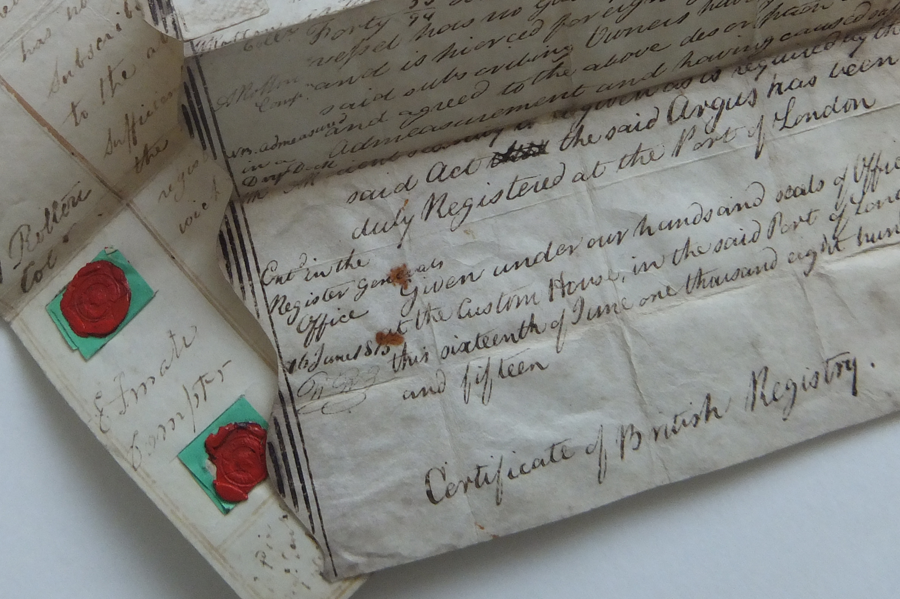Two mysterious British Certificates of Registry — partially illegible from wear, if not overzealous cursive — washed up on these foreign shores. Purchased from a dealer in antiquarian books, they both reference a cutter originally named Argus of London, built in Kent on the 17th of March 1813.
by Caitlin Greyling
The vessel was then subsequently re-registered in 1848 under the name Victoria of Ramsgate. In the 1800s, it was necessary to note the vessel dimensions, including ton admeasures — as decreed by King George. However, at this point, things get a little interesting!
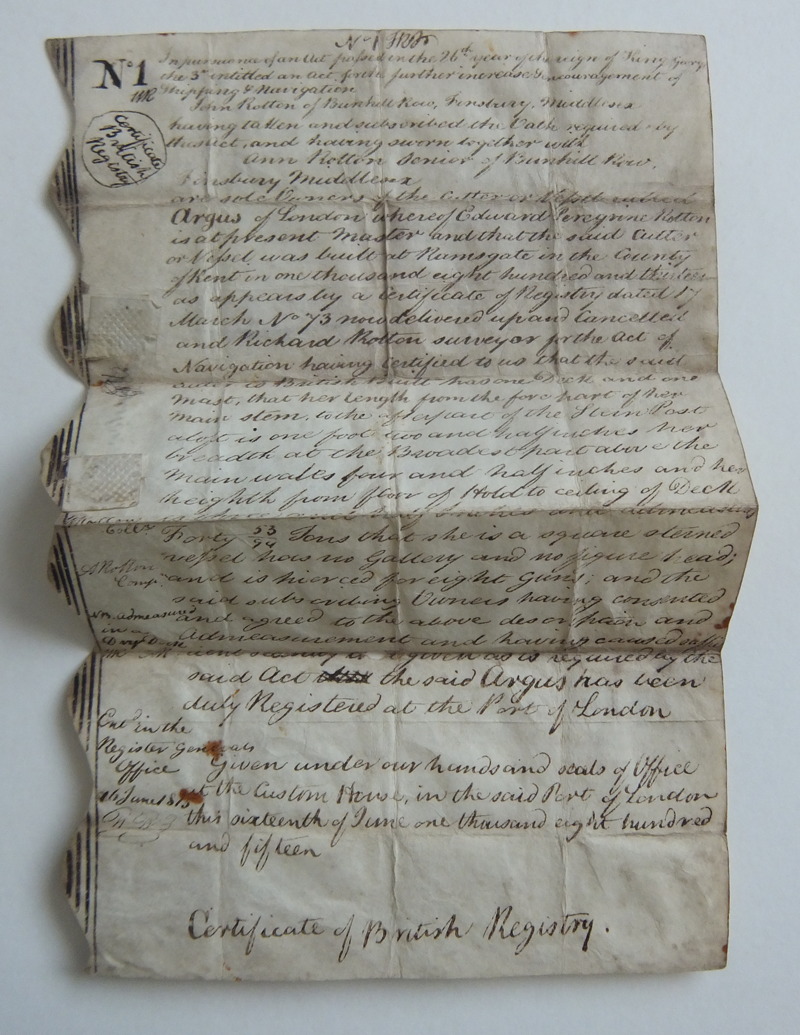
Transcript of the front page of the 1815 British Certificate of Registry No.1:
“No. 1
[Flourish]
Certificate
British
Registry
[Flourish]
R. Rotton1
[Illeg.]
A. Rotton
[Illeg.]2
NB.
Admeasured
in a Dry Dock
[Two
flourishes]
Ent’d. in the
Register
Generals
Office
16 June 1815
[Flourish]
In pursuance of an Act passed in the 26th year of the reign of King George the 3rd entitled an Act for the further increase & encouragement of Shipping & Navigation John Rotton of Bunhill Row, Finsbury, Middlesex having taken and subscribed the Oath required by this Act, and having sworn together with Ann Rotton Senior of
Bunhill Row, Finsbury Middlesex are sole Owners of the Cutter or vessel called Argus of London whereof Edward Peregrine Rotton is at present Master and that the said Cutter or Vessel was built at Ramsgate in the County of Kent in one thousand eight hundred and thirteen as appears by a Certificate of Registry dated 17 March No. 73 now delivered up and cancelled and Richard Rotton surveyor for the Act of Navigation having certified to us that the said cutter is British Built has one Deck and one Mast, that her length from the forepart of her main stem, to the afterpart of the Stern Post aloft is one foot two and half inches her breadth at the Broadest part above the Main wales four and half inches and her heighth [sic] from floor of Hold to ceiling of Deck is three and half Inches and admeasures Forty 53/94 Tons that she is a square sterned vessel has no Gallery and no figure head; and is pierced for eight Guns; and the said subscribing Owners having consented and agreed to the above description and Admeasurement and having caused sufficient security to be given as is required by the said Act the said Argus has been duly Registered at the Port of London.
Given under our hands and seals of Office at the Custom House, in the said Port of London this sixteenth of June one thousand eight hundred and fifteen.
Certificate of British Registry”
Things Aren’t Measuring Up
While all seems in order with both British Certificates of Registry, only some are above board. On closer inspection, the oldest certificate reveals some interesting details. Just 36.8 cm long, 11.43 cm wide, and 8.89 cm tall and calculated to admeasure “Forty 53 over 94 tons,” the Argus is rather a curious vessel.
Note; tonnage admeasure is generally a ship’s capacity, not its actual weight. A little research also reveals that “Forty 53 over 94 short tons” is a very tiny load.
The subsequent certificate is purportedly for the same boat, now named Victoria of Ramsgate three decades later. Similarly, its dimensions are just as astounding. At just 45.72 cm long, 15.88 cm wide, 7.87 cm tall, and admeasuring 120 tons new, it’s decidedly pint-sized.
A ship of this load-bearing capacity should also be at least 70 feet long, Luca Rapisarda of the Lloyd’s Register Foundation commented. It’s possible the admeasures mentioned were simply a fictional load or that the admeasure “ton new” is a unique formula. Ships were also required to meet certain plank thickness standards.
However, the dimensions on both British Certificates of Registry do specifically mention the vessel’s length, breadth, and height, as required by the Act of General Registry 1786. The Registrar would have picked up any mistakes, Luca claims. So it’s unlikely the small or mismatched measurements — or the differences between the two boats — are an error.
Are the Argus and Victoria the Same Boat?
Ultimately, the two Certificates of Registry seem to speak of the same mysteriously small boat. Both were built at Ramsgate in the County of Kent in 1813 and square-sterned with no gallery or a figurehead. Only the earliest certificate mentions the craft being pierced for eight guns. Perhaps a small omission in the second certificate, not any difference, as specifying gun ports may not have been a necessity.
The most notable difference is the change of boat type from a cutter in 1815 to a schooner in 1849. While the former generally featured one mast, the latter usually had two — as specified in the differing vessel descriptions.
That said, the first registration certificate specifically mentions the Argus being built in 1813 and registered on the 17th of March under certificate No. 73. At the subsequent registration of the Victoria on the 19th of April 1848, Certificate No. 73 was also produced. Meaning that they should both be the same vessel. The second certificate also reveals that the year of initial registration under certificate No. 73 was 1814.
The most likely explanation for the additional mast is that the ship was modified in between registrations. Perhaps even just before being re-registered in 1848, as Kent is a well-known ship-building county.
Mary Jo Barber — who, thankfully, translated both certificates to modern English — had a few more fitting explanations to offer:
- Different systems were used to measure each boat — perhaps even non-standardized measurement equipment.
- The wood could have expanded or shrunk over the years, as it does tend to bulge, shrink, and warp.
- Similarly, the differences in ton admeasure were likely from the boat modification.
- Or, the differing admeasures could also be down to the use of different measurement systems — though the 100-base Moorsom system was not created until 1849.
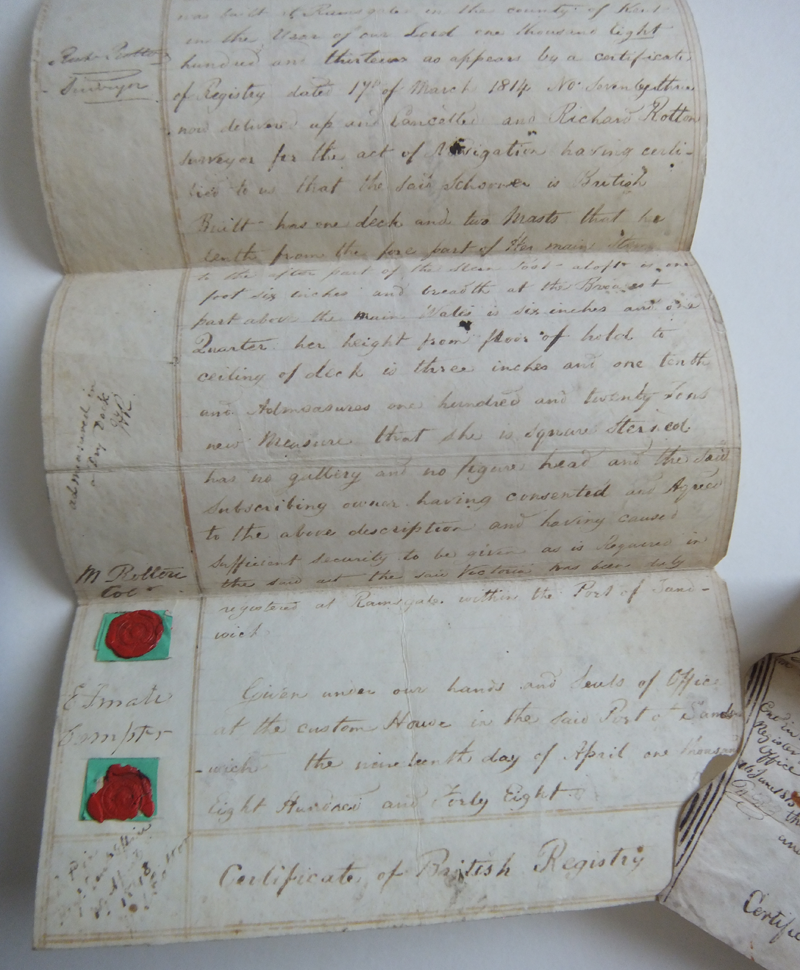
Transcript of front and back page of 1848 British Certificate of Registry No.1789:
“No. 1789
Richard Rotton
Surveyor
Admeasured in a Dry Dock
[Flourish]
M Rotton
[???]
[Name]
Compter
In pursuance of an Act passed in the twenty-sixth year of the reign of his late Majesty King George the third Entitled an Act for the further increase & encouragement of Shipping & Commerce John Francis Rotton of Watford in the County of Hertford having taken and subscribed to the Oath required by this act and having Sworn he is the owner of the Schooner or Vessel called Victoria of Ramsgate in the County of Kent whereof the said John Francis Rotton is at Present Master and that the said Schooner was built at Ramsgate in the county of Kent in the Year of our Lord one thousand Eight hundred and thirteen as appears by a certificate
of Registry dated 17th of March 1814 No. Seven [Illeg.] now delivered up and Cancelled, and Richard Rotton, surveyor for the Act of Navigation, having certified to us that the said Schooner is British Built, has one Deck and two Masts that the Length from the fore part of Her main stem [?] to the after part of the Stern Post aloft is one foot six inches, and breadth at the Broadest part above the Main Wales is six inches and one Quarter: her height from floor of hold to ceiling of Deck is three inches and one-tenth and Admeasures one hundred and twenty tons new Measure that she is square Sterned has no gallery and no figurehead and the said subscribing owner having consented and Agreed to the above description and having caused sufficient security to be given as is required in the said act the said Victoria has been duly registered at Ramsgate within the Port of Sandwich.
Given under our hands and Seals of Office at the Custom House in the said Port of Sandwich the nineteenth day of April one thousand Eight Hundred and Forty-Eight.
Certificate of British Registry.”
Child’s Play or Sleight of Hand?
Unless forged or counterfeit, our only joint conclusion is that the Argus — subsequently the Victoria — was, in fact, a toy boat. The ownership of the craft further proves this possibility, as Mary Jo found out when she dug deeper. Her research into the family lineage reveals that the vessels remained in the hands of a single family. The Rotton’s, originally of Bunhill Row Finsbury Middlesex — now modern-day North London. A rather landlocked area of England, apart from the Thames.
Not only that but the craft itself was surveyed by a Richard Rotton (est born 1799) on both counts. First at the Port of London in 1815, when he would have been around 18 years of age. Then, again in 1848 at the Port of Sandwich in Kent, when he would have been 49. This is an unusual occurrence, as port surveyors would not usually be the family or owners of a vessel but employees of the port.
Note the vessel also returned to where it was built when re-registered as the Victoria — to the County of Kent. It’s most probable that Richard engaged in a game with his siblings. Naming his parents as vessel owners, himself as the surveyor, and the younger of them masters of the vessel. Another fun fact would certainly point to this conclusion.
Name Inspiration
In 1813, an infamous enemy US warship was also captured off the coast at around the same time the Argus was built. It, too, was called the U.S.S Argus. Prior to privateering the English coast, it has just completed a top-secret mission. Before its demise at English hands, it delivered diplomat William Crawford safely to his post at Napoleon’s court in Paris from the US. Naturally, such a tale would inspire children nearby — especially in regard to the naming of a toy boat for pretend play.
Tax Evasion
It’s also possible that the Argus’s unbelievably tiny dimensions were, in fact, a way to dodge sailing regulations. Maybe to pay less tax, as Mary Jo hypothesized. To evade authorities or intentionally incorrectly classify the vessel type and its load capabilities. The Rottons are seemingly seafarers, not simply country folk, after all. That Richard, perhaps being an actual surveyor, was able to utilize his authority at the port to do just this.
A Family Affair
One thing is for certain; the vessel stayed in the hands of the Rottons. According to Mary Jo’s research, its original owner on the earliest certificate, John Rotton, is also the father of the first master of the ship — an Edward Peregrine Rotton. Subsequently, the craft was transferred on 15th February 1817 to another Rotton. Whose first name is unfortunately utterly illegible to all of us due to wear.
Though, the term “Senior” is prominent, implying it may have been transferred to an elder Rotton. Since its master and owner on the 1848 certificate, John Francis Rotton, was only born in 1838, he’s not the likely candidate. So we can only imagine the ship has transferred hands many times within the Rotton family. Perhaps even that there may be a few other certificates of registry for the Argus out there!
Inexperienced Ship Masters
Interestingly, John Francis is also the son of the ship’s surveyor, Richard Rotton, and the grandson of the original owner John Rotton. Argus’s Master, Edward Peregrine Rotton, was also just a toddler when it was registered in 1815. Being born in 1811, he would have been around 3 years old, noted Mary Jo.
John Francis Rotton was also rather young, aged around 11 years old when mentioned as owner and master of the Victoria. Luca Rapisarda of Lloyd’s Register Foundation commented that it would be unlikely to find a Master so young. In 1848, they had to go through training, making most Masters around 20 to 30 years of age.
Other notable Rottons include Ann Rotton, also mentioned as the original Argus co-owner on the 1815 certificate. The spouse of John Rotton, she’s also the mother of another John Rotton (born 1798), who seems to have migrated to Australia in 1821 before marrying an Elizabeth Harpur of Winsor. Another Rotton son, Walter, was purportedly born in 1800 and also emigrated “down under.” On the 1848 certificate, M. Rotten is stamped in the sidenote. Perhaps also a wife, most likely of Richard Rotton. A family affair, indeed!
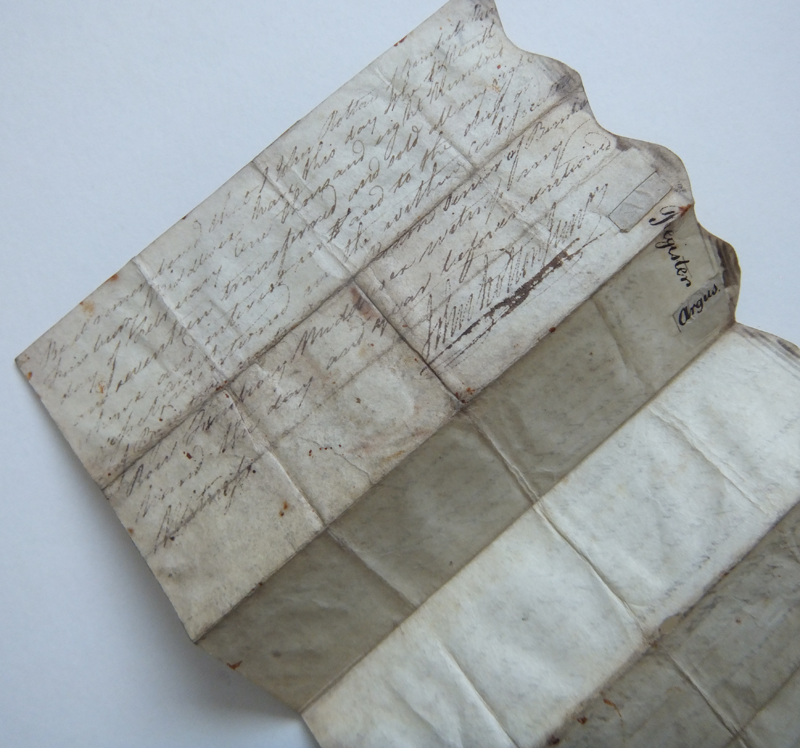
Transcript of the back page of the 1815 British Certificate of Registry No.1:
“Be it remembered that I, John Rotton of Bunhill Row Finsbury Middlesex, have this day, the fifteenth day of February one thousand eight hundred and seventeen, transferred and sold all my rights share and interest in the Argus as registered in the within Certificate of Registry [illeg.] Rotton Senior of Bunhill Row Finsbury Middlesex witness our hand the day and year beforementioned Witness.
Signature
Register
Argus
Cert. Argus
[Flourish]”
A Ship of War?
One interesting tit-bit that Mary Jo Barber noticed is the mention of the Victoria being licensed for privateering on the 14th of February 1830. Much like pirates, privateers attacked ships, pillaging them of their loot and capturing them and their men. However, privateers were licensed to do so by their state, generally during times of war. Usually company- or privately-owned ships, privateers were limited to attacking only enemy ships.
They also needed to possess documents — usually a letter of marque — to prove they were allowed to carry out their looting, lest they be caught and classed as pirates or buccaneers, subsequently imprisoned or hanged at the gallows! The main targets were generally commerce ships. Anything snatched had to be presented to the court to be transferred legally to the privateer.
As privateer’s pay mainly consisted of loot, the setup offered the British government an affordable way to scale its assaults and military. England, in particular, was well-known for being a terror on the sea, especially in the early 1800s. The Argus was actually built and registered in the 1810-1815 period when the USA, France, and England were at war. At the time, privateering and attacking US and French ships would have been commonplace south in the English channel.
Privateering also became an issue, as some factions would start targeting state and friendly ships to make more money. The act was only outlawed in 1856, incidentally just a few years after the Victoria was re-registered as a schooner in 1848. The revolutions of 1848 were sweeping the foreign nations of Germany, Italy, France, and Austria at the time.
Is it possible that the Argus was actually a real privateer or pirate ship? Perhaps under the protection and secrecy of the British Navy? Or simply the children’s way of connecting to the current causes of their time. To take part, setting sail to overthrow Napeolean and his US allies, in particular. If the ship was a toy, it’s clear to see the kids were sticklers for details, right down to setting Kent as its place of construction. The predominant ship-building County in the nation at the time.
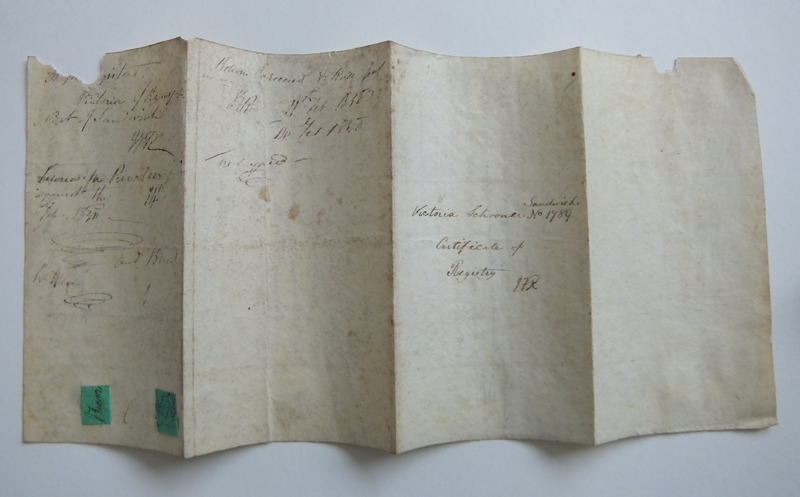
Transcript of the back page of the 1848 British Certificate of Registry No.1789:
“[missing] Register
Victoria of Ramsgate
Port of Sandwich
Flourish
Licensed for Privateer
Against the – 14th1
Feb 1830
Flourish
And [illeg.]
Flourish
One green stamp reading J. Francis
One green seal containing
illegible writing
Rotton [illeg.] to [illeg.]
Flourish
14th Feb 183?
11 Feb 18??
This agreed2
Flourish
Sandwich
Victoria Schooner No.1789
Certificate of Registry
Flourish”
A Knight in the Family
On researching the family further, particularly the last-known owner and master of the Victoria — John Francis Rotton — Mary Jo discovered he was also knighted a Sir. Though it’s possible he served in war, this is not necessarily the case. After the 16th century, knighthood was a lot less strict. Instead, it became a popular way for royals to award their favorite citizens and court members for exemplary acts of service. Sir Francis Rotton did bequeath his entire library collection to the University College London — some while alive and the rest posthumously.
A generous act indeed! He was also a member of the UCL council for 30 years. You can tell a lot about a man by the books he reads. The collection mainly consists of theology, philosophy, travel, and literary tomes dating from as far back as the 15th century. It’s clear to see he was deeply interested in exploration, both of the New World and closer European shores. One notable piece of the donated collection includes a narrative by Sir Joseph Banks of Captain Cook’s first voyage.
Rotton Roots
Though it can be challenging to trace lineages, the Rottons appear to be of Irish and English descent. Notably, the family has a long history of seafaring and exploration in their bloodline.
1677: A marriage of a John Rotton and Bridget Stearne can be found on page 74 of The Thirty-First Report of the Deputy Keeper of the State Papers in Ireland.
1702: A Mr. John Rotton is also frequently mentioned in The Story Of A Family
Through Eleven Centuries by Raymond Gorges in Dublin.
1774: A Robert Joseph Rotton of Derby is mentioned in the Falkirk archives of William Forbes, a coppersmith in London.
1780-1782: A Robert Rotton is mentioned as the captain of a ship that sailed for New York from St. John’s, Newfoundland, in 1780, only to get shipwrecked at Bophin Island near Galway, Ireland. The survivors of the wreck then made their way south through Ireland to England, arriving there in 1782.
1778-1783: An R.T. Rotton of Swansea is mentioned as potentially a correspondent of a shipbuilder or overseer of ships being built in the 1778-1782 period in the Forbes archives. In 1779, another Mr. Rotton corresponded with William, most likely in regard to procuring Navy bills. Some additional business and personal correspondence with an R. J. Rotton of Swansea and Mr. Rotton in 1781 and 1783 are also noted.
1800s: An 18-year-old Edward Rotton is mentioned as the midshipman on the H. M. S. Dreadnaught. You can find the listing on page 67 of The Trafalgar Roll. It was launched shortly after the union of Ireland and Great Britain.
Where’s the Argus Now?
Though mysterious, there are many explanations for the curious dimensions mentioned on these two British Certificates of Registry. The most plausible design of the Argus of London is that of a toy boat. Most likely, it was created for the children to play pretend seafaring wars.
Do you know the whereabouts of the Victoria of Ramsgate now?
Special thanks to Mary Jo Barber, Luca Rapisarda, and the active participants of the history section of the British Merchant Navy forum for their help unraveling the mystery of the Victoria, née Argus.


